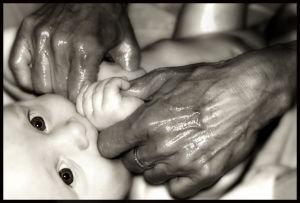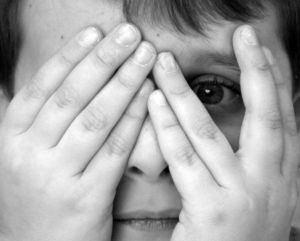By Robin Gillies, LMT, www.breathingroomnyc.com
 The secret of infant massage, in my opinion and experience, is this: Mothers and fathers — especially those who practice Attachment Parenting and therefore really in touch with their children — will know instinctively how to touch their babies.
The secret of infant massage, in my opinion and experience, is this: Mothers and fathers — especially those who practice Attachment Parenting and therefore really in touch with their children — will know instinctively how to touch their babies.
Here is what I think you need to know: Most babies prefer to be touched with lubrication. Their skin is so sensitive that dry touch can feel tickle-like.
Always use a pure, food-grade oil that is free of preservatives and fragrances — ideally, organic. Babies put their body parts in their mouths, so they are likely to ingest whatever you’re using. Also, the skin is the largest organ of the body and it absorbs everything that is put on it. So if you wouldn’t spoon-feed it, don’t apply it to the skin. In the same vein, never use any products that contain parabens or any petroleum derivatives. Mineral oils are linked to lung problems and skin disorders. And, obviously, they are non-renewable resources. Other than being incredibly cheap for cosmetic companies, they have no value.
Interview by Art Yuen, leader for API of New York City USA & member of the API Board of Directors
ART: Where did you receive your training in infant massage?
ROBIN: I was trained and certified through The Loving Touch Foundation. Interestingly, it was in these classes that I learned all about Attachment Parenting for the first time.
ART: You mention that effective massage isn’t about the strokes. Can you expand on this?
ROBIN: All groups that train and certify teachers have some protocol of strokes that they teach. And this isn’t a bad thing. It gives parents and teachers a way to organize their approach. All of us like to have direction when we’re feeling at a loss as to “where to start.”
But if parents feel like they’re not “qualified” to be massaging their own babies simply because they don’t know the “strokes,” I feel it’s my job to quickly demystify the whole thing.
Also, a checklist of strokes is often a challenge for perfectionist types or anyone who finds it difficult to leave a task undone, like me. I’ve seen parents insist on finishing a stroke ten times on one leg because it is on their handout, even though their baby is writhing and pulling away. They just can’t stand to leave the stroke undone.
So, now when I teach, I try to teach parents a variety of approaches while highlighting the ones that seem to work. I’ll say, “Wow, look at that: She’s really smiling when you do that. Keep that in mind and see if it’s as big a hit next time.” This seems to help parents remember a relevant stroke, and I hope it helps to reinforce responsiveness.
What I tell parents: Don’t worry about the strokes — just touch your baby a lot and often — so long as baby seems to like it.
Infant Massage
Infants move through a cycle of “alert” states:
- Drowsy
- Quiet Alert
- Active Alert
- Crying
We want to massage our infants in the quiet alert state. I find it interesting that so many books and teachers encourage after-bathtime massages — which usually precedes sleep time — when babies are restless, irritable, and tired. Bath time is great because our babies are conveniently naked. But if they are not in the quiet alert state, it is not a good time for massage.
How do we know if they are in the quiet alert state? Their bodies are relatively still. They are not crying. And they make or keep eye contact with you. Usually after waking and a feeding, babies will be content to be massaged.
How to do it:
- Find a place that is comfortable for you and baby. On the floor is a great place, if you are comfortable. Have a small pillow or rolled-up blanket to place under Baby’s head to assist him or her in easy eye contact. The comfort of the massage “giver” is fundamental. So find a position that you enjoy that keeps you both stable, relaxed, and in eye contact with one another.
- Baby should be in just a diaper, or naked on some sort of wee-wee pad or water-resistant surface.
- Make sure the room is very warm, and select soft music that your baby seems to relax to. Ideally, use the same music every time, as the baby will begin to associate it with relaxation time.
- Use a little bit of oil on your hands, rubbing them together to warm both your flesh and the oil before touching the baby. Feet or toes and legs are a good, non-invasive but nerve-rich places to start. Play with pace, rhythm, direction of your touch and just observe your baby’s responses. Giggles, smiles, and coos? Or a grimace and a withdrawn limb? This is the art of infant massage. The silent body language communication. If your baby expresses dislike, try more or less pressure, or a broader surface — using your palms versus finger tips is usually a good rule of thumb with babies. If that doesn’t work, move on to another body part.
- Approach the tummy gently. Downward and clockwise strokes can assist movement of gas and digestion. Then maybe the chest, and arms, hands, or fingers. Face massage is taught, but very few babies like it. Try it with yours: forehead, cheeks, chin, ears, and scalp. But watch closely for cues of irritation.
- As you touch your baby, notice your breath and your thoughts. We convey so much through our hands. So breathe, be present, and talk to your baby using language that they can associate with this sort of touch. Use words like “breathe,” “relax,” and “melt.” If this feels inauthentic to you, maybe sing a lullaby or hum along with the background music. Be especially mindful of your state of mind when your hands are in your baby’s heart and energy center — the chest and tummy. We are all extra, extra perceptive and vulnerable here.
- You can be playful, too! Make up fun sounds with the strokes. Look for sounds that make your baby laugh or smile. Feel free to creatively name the strokes, like “airplane taking off” and make an airplane noise. Your infant will become a toddler soon enough, and this will be a fun familiar massage experience for him or her.
- You may flip the baby over on to his or her tummy for back massage. I always take off the diaper for this because, while necessary, diapers energetically “cut off” the torso from the lower body and long connective strokes with the whole palm of the hand from nape of the neck down to the toes can be very, very helpful. I have found that because most babies have a limited tolerance for massage and for tummy time, it is often better to do the work on the back in an entirely different session. Let it stand alone. And let it be brief. Sometimes a mirror or satisfying rattle or soft toy in baby’s hand while on their belly can keep them peaceful for a few more minutes.
How long should massage last? Ask your baby! It will vary every time. And while massage is relaxing, it is also stimulating for babies. So watch for cues that the quiet alert phase has passed. Averting eyes, squirming, and crying out are all signs.
Frequency is going to be more important than length. So don’t worry if it’s only two or three minutes. Don’t get hung up on thoughts like, “I haven’t gotten to the chest yet!” Just remember where you left off and start somewhere else next time.
Always end your session with lovies and huggies and snugglies and, “I love you’s.”
Never give massage if you’re not in the mood. I cannot say it enough: Everything comes through your hands. If you are anxious, impatient, tired, worried, or not present, your baby will begin to learn these emotions to be associated with the experience of massage.
Massage as a Part of the Sleep Routine
Therapeutic and loving touch can be incorported in to bedtime routines even if the child is not in a quiet alert state, but the approach will differ. Best to have the baby clothed and try long-holding techniques.
Some babies really get grounding from holding of the feet. If they kick and pull away, let it go. Another move all humans love is to have one hand under the small of the back and one hand resting gently on the tummy. This embrace of the solar plexus can be so comforting and quieting. Experiment with a hand just under the small of the back, just on the tummy, and then both at the same time. See how baby responds. Also, holding the baby’s head in your palms with your finger tips gently resting at the place where the skull meets the neck may work.
Holds should be patient and long and still — as long as you observe a gradual quieting of the baby as opposed to agitation or irritability. This is a great time to close your eyes and enjoy your loving thoughts about baby. Think about all the adorable positive moments you had all day. Picture your baby’s beautiful face, smile, and body; remember how it feels to hold them in your arms. Let the energy of these thoughts wash over you. You will — without having to try — be transmitting this to the baby. If you are in to visualizations, try inhaling a bright white light in to the crown of your head and exhaling it out of the palms of your hands in to your baby’s body. If negative thoughts come to you, such as regret or guilt over those moments of the day when you lost your patience or let yourself down, use this time to give some self-love talk: “I love myself when I’m less than the parent I want to be” or “I love myself when I am impatient.”
Your baby will tell you how long the holds should last. Some babies will drift off to sleep. Others will quiet but then crave the rest of their bedtime routine: rocking, nursing, singing, or whatever it may be. Follow their cues.
Massage for Toddlers & Older Children
My son is now 26 months old, and I have not been able to massage him regularly since he was about 16 months old. I miss it, but I’m not worried about it. He must come to it himself now. I was taught that if you massage your baby consistently as an infant, he’d simply grow to be a toddler who craved it. But this seems to conflict with all of my experience, both with Jackson and with my friends’ and clients’ children. All of us who are in or who have been in toddler land, know that having them sit still long enough for a diaper change is challenge enough. So I will offer some ideas for introducing massage to the toddler or older child, but the most important guideline here is, as ever: Let them lead.
After almost a year of disinterest, Jackson has suddenly become interested in massage after seeing me give a massage to my sister. He was fascinated. She was on the floor, and I was doing some combination of Thai, Shiatsu, and Deep Tissue with Oil and he just jumped right in. He was palming her back, rubbing her feet, tickling her, and playing with her hair. Ultimately, I just backed away and watched him respond to her experience of his touch. He saw immediately that she liked having her head rubbed, so he did it for a long time.
The next day, we were on the subway and he licked his finger and then wiped it on my arm. Again and again and again. I asked him what he was doing and he said, “Giving Mommy massage.”
So, my idea about toddlers and older children is rooted in this limited, but I sense also universal, experience: Let your children see you massage someone else that they know, love, and trust.
Again, you don’t have to be a professional massage therapist. Just get some good oil, sit across from a friend, partner, or family member on kitchen chairs with one of their feet resting on your thigh, and give a little foot or calf rub in front of your child. Or while watching your child play, lay another person down on the floor right in the middle of the child’s play space and start to squeeze shoulders — even through the clothes is fine. If you’re not sure what to do with your hands, just think: how would your tired back, neck, arms, or head like to be touched?
Oil in a colorful container can get a child’s attention. Encourage your massage recipient to give directions or to express pleasure in a way that is natural and authentic for them: “That feels so good,” “a little lower,” “not so deep,” or simply, “mmmmmmm…..”
An instructional video: http://lovingtouch.com/catalog/product_info.php?cPath=11&products_id=47&osCsid=jgave8p2dr9lilgpp21nked9f1
Books: A Vital Touch by Sharon Heller & Touch by Tiffany Field
We live in a touch-deprived society wherein most of our kids learn touch in either a violent or sexual context. Introducing massage gives babies, toddlers, and children a healthy experience of touch. Offer massage in your household. Make therapeutic touch a part of your everyday life and I believe that in his or her own time, the toddler or older child will be attracted to its power. Never force it. Always stop when they say stop. It should be an empowering experience. When they know how it feels to be touched in a way that feels good, they will know what it means to not like certain touch. They will develop body awareness, boundary awareness, and respect for both their own and other’s bodies. Enjoy being a part of this priceless lesson in life!
Editor’s Note: Read an in-depth interview on infant massage with Linda Storm and Suzanne Reese of Infant Massage USA in the New Baby 2010 issue of the quarterly The Attached Family magazine, due out to readers in June.
 Earlier this year, I attended a day session put on by the Appelbaum Training Institute in Omaha, Nebraska USA. The purpose of this session was to train childcare providers, but it gave some great tips for parents, too, in dealing with acting-out behavior from their toddlers and preschoolers:
Earlier this year, I attended a day session put on by the Appelbaum Training Institute in Omaha, Nebraska USA. The purpose of this session was to train childcare providers, but it gave some great tips for parents, too, in dealing with acting-out behavior from their toddlers and preschoolers:



 The secret of infant massage, in my opinion and experience, is this: Mothers and fathers — especially those who practice Attachment Parenting and therefore really in touch with their children — will know instinctively how to touch their babies.
The secret of infant massage, in my opinion and experience, is this: Mothers and fathers — especially those who practice Attachment Parenting and therefore really in touch with their children — will know instinctively how to touch their babies. In the United States alone, there are 3.2 million referrals to social services on allegations of child maltreatment each year — one-quarter of which are found to have a substantiated case of physical or sexual abuse or severe neglect. Seventy-five percent of these founded cases of abuse or neglect had no prior history. It’s an astounding number of children who aren’t living in safe, loving homes — especially knowing that these numbers don’t count the abused and neglected children living around the world. It’s a number that child maltreatment prevention researcher David Zielinski, PhD, wants to stick in your mind.
In the United States alone, there are 3.2 million referrals to social services on allegations of child maltreatment each year — one-quarter of which are found to have a substantiated case of physical or sexual abuse or severe neglect. Seventy-five percent of these founded cases of abuse or neglect had no prior history. It’s an astounding number of children who aren’t living in safe, loving homes — especially knowing that these numbers don’t count the abused and neglected children living around the world. It’s a number that child maltreatment prevention researcher David Zielinski, PhD, wants to stick in your mind.